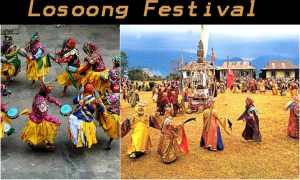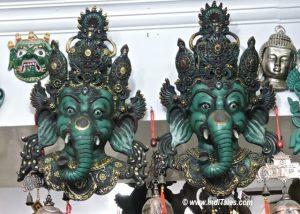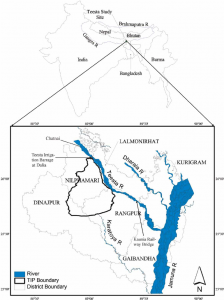Fairs and Festivals of Sikkim
People and Culture of Sikkim
- The People of Sikkim consist of three ethnic groups, that is, Lepcha, Bhutia and Nepali.
- Communities of different hues intermingle freely in Sikkim to constitute a homogenous blend.
- Hindu Temples coexist with Buddhist Monasteries, Churches, Mosque and Gurudwara.
- The predominant Communities are Lepchas, Bhutias and Nepalese.
- These myriad Cultures has produced a quintessential Sikkimese Culture that encompasses all ways and walk of life, but has also managed to preserve their own identity.
- These can also be seen in the various places of Worship, Festivals and Cultural dances that are celebrated through the year.
List of major Fairs and Festivals
Loosong/Namsoong
- Lossong celebrated all over Sikkim marks the end of the harvest season at the end of the tenth month of the Tibetan Year.
- Taking cue from a good harvest and praying for even better prospects for the next crop, the festival is marked by religious masked dances in Enchey Monastery.
- The dances symbolize the exorcizing of the evil spirits and the welcoming of the good spirits for the new year.
- Lossong has now become an important festival where visitors from all over the world can get to see the local sporting events like archery, climbing of greased pole.
- Local cuisine, handicrafts, floriculture and cultural programmes are some of the added attractions during the festival.
- The festival is organized by Tribal Youth Association of Gangtok.
Lampokhari Paryatan Mahotsav, Aritar
- Located at a height of 5100 ft, Aritar is surrounded by lush green forest, lakes and paddy fields.
- The entire Khanchendzonga range can be viewed from this place. Aritar offers adventure sports, nature trails.
- Lampokhari is one of the serene lakes where one can enjoy boating.
- Added attractions are Aritar Monastery, Mankhim Dara, Phusray Lake, Pango Lakha and Rachela
Baisakhi Festival, Makha Tumin –Lingee
- Organised to herald the spring season and the Nepali New Year.
- Cultural programme, traditional customs, local cusinies and other local activities can be experienced
Sakewa
- Sakewa is celebrated with great fervor by all the Kirat Khambu Rai community.
- Also known as Bhumi/ Chandi Puja or land worshipping ceremony it is celebrated all over the State.
- It is celebrated at that time of the year when cranes migrate to the Northern Hemisphere this indicates sowing season of cucumber, pumpkin and other kharif crops.
- The festival begins with Shakti Puja at Mangkhim (temple) performed by a Chief Priest (Mangpa) for good harvest followed by the Shova Yatra.
- Various traditional dishes like Wachipa, Bongchipa, Arakha Hengmawa, Baksa and Okrukma are served.
Saga Dawa
- Full moon day of the 4th month in the Tibetan Lunar Calendar, around end of May and early June.
- Saga Dawa is a very important festival for the Buddhists.
- This day is considered to be the holiest of the holy Buddhist Festival.
- On this day Lord Buddha took birth, achieved Enlightenment and passed away attaining Nirvana.
Bhanu Jayanti
- A cultural festival organised to celebrate the birth anniversary of the Nepali poet, Bhanu Bhakta Acharya.
- Competitions for school children are organised in various field such as poetry, drama etc.
- Other programmes include cultural parade and culture programmes.
Drukpa Tshechi
- This festival celebrates Lord Buddha’s first preaching of the Four Noble Truths to his first five disciples at Saranath.
- The festival is held on the 4th day of the 6th month of the Tibetan lunar calendar.
- Prayers are conducted in the major monasteries all over the State.
Namprikdang Namsoong , Dzongu, North Sikkim
- Namsoong is celebrated to welcome the good spirits for the New Year.
- Namsoong has now become an important festival where visitors from all over the world can get to see the local sporting events like archery, pole climbing etc Local cuisine, handicrafts, floriculture and cultural programmes are some of the added attractions during the festival.
Cherry Tea Festival Temi South Sikkim
- Tea plantation at Temi, South Sikkim was commenced in the year 1969.
- The plantation ranges between the elevation range from 1460 to 1890 msl.
- Temi being agro- climatically suitable for cultivation of China variety of tea plants initially procured from Darjeeling Tea Gardens.
- The tea factory with orthodox type of manufacture was established in 1977.
- The garden is consistently producing superior quality tea acceptable to wide markets both international and domestic segments.
- The festival is organised with objectives as under:
- To promote Sikkim (Temi) Tea globally.
- To promote new destinations in and around South District.
- To promote home stays and village tourism in order to enhance and generate income of the local community.
Lhabab Duechen
- This festival epitomizes in a significant manner the descent of Buddha from the heaven of the thirtythree Gods after visiting his mother.
- It is universally believed that Lord Buddha through his spiritual powers came to know about the whereabouts of his mother who did not live for a long time after his birth.
- After gaining the necessary information about his mother he ascended to Heaven where he delivered sermons to his mother and other celestial beings.
- During this period the disciples of the lord could not bear his long separation and longed to hear his preaching.
- Buddha finally relented and descended on earth along a triple ladder that was prepared especially for the occasion by Viswakarma
Barahimizong
- The festival of Barahimizong is celebrated by the Mangar community living in Sikkim.
- The celebration reflects the faith in almighty as the bestower and protector of mankind.
- Through this festival, the gratitude to God is expressed by offering fresh harvest and seek good fortune for the coming days.
Dasain ( Durga Puja)
- Also known as Durga Puja, this fortnight long Hindu festival usually falls in the month of October.
- The festival symbolizes the victory of the Hindu Goddess Durga over evil.
- Barley seeds are sown in the soil on the first day of this festival and their growth foretells good harvest.
- A week later is “Phulpati “meaning the day of flowers, followed by Maha Astami and Kala Ratri and Navami.
- The 10th day of the festival is known as Vijay Dashmi and also marks the victory of Lord Rama over Ravana.
- During this day people smear their foreheads with colored rice and the barley sprouts, which was sown on the first day of Dasain, are picked and placed over the ears.
Indrajatra
- Indrajatra is an important religious festival celebrated with pomp and fanfare by the Newar community in Sikkim.
- It is belived that many centuries ago, Indra (king of Heaven)’s mother needed specially scented flowers (Parijat).
- Indra looked for them but could not find them in heaven.
- Indra discovered Parijat flowers in the Kathmandu Valley and tried to steal them for his mother. He was caught and imprisoned by people in the Valley.
- Indra’s mother came searching for him and people were shocked to know what they had done.
- They released Indra and dedicated one of the most colourful festivals of Nepal to him to calm down his anger.
Pang Lhabsol
- Pang Lhabsol, a festival unique to Sikkim is celebrated to offer gratitude to Mt Khanchendzonga, the Guardian Deity of Sikkim and to Yabdu, the Supreme Commander.
- Rabong is now emerging as one of the important Buddhist Pilgrimage Destinations. Situated at the base of Maenam Hill, a sub-divisional headquarter and transit point for beautiful spots such as Chozo Lake, Ralong Monastery, Manilakhang Sakyamuni Cultural and Pilgrimage Centre and various tourist destinations of South Sikkim, Base Camp for trekkers to Maenam Hill and Borong Hot Spring.
- A trek down to the sacred lake “Shar Chok Bhepu”, one of the four holiest caves in Sikkim, would be a memorable experience.
Namchi Mahotsav Namchi ,South Sikkim
- Namchi – “Top of the Sky”, nestled among the hills at an elevation of 4,400 feet.
- The town commands a panoramic view of the surrounding hills and snow capped mountains and stretches of the valleys below.
- It is an excellent place for short stay and village excursions.
- Samdruptse “The Wish Fulfilling Hill” has 135 ft high statue of Guru Padmasambhava which is the highest in the world.
- Siddheshvara Dham (Char Dham) is another state of the art pilgrimage centre wherein replica of all four Dham has been built around an eighty seven feet high statue of Lord Shiva.
- All 12 jyotirlingaas are also built around the temple complex.
- With so much to offer to the visitors the Toursim Committees are actively involved in promotion and publicity of Namchi, South Sikkim.
- Every year Namchi Mahaotsav is celebrated in the month of October.
- There are activities like traditional sports, sale and exhibition of local arts and handicrafts, cuisine, flower show and sale etc.
Kagyed Dance
- Kagyed dance, a customary dance festival, celebrated annually in Sikkim falls on the 28th and 29th day of the tenth month according to Tibetan calendar, which according to English calendar falls in the month of December.
- In the name of eight tantrik Gods and Goddesses commonly called Kagyed, lamas on these days perform dances and sing songs in different monasteries and offer prayers to them requesting these deities to save human beings from the tormenting evil spirits and to bless them for good health and fortune.
Red Panda Winter Festival, Gangtok
- The winter season in Sikkim draws a spectacular image of Mt. Khangchendzonga in its ivory grandeur, providing an alluring background while corpuscular rays pierce through the scudding clouds over the skies, adorning Sikkim perfectly for the cold season.
- Red Panda Winter Festival previously known as Sikkim Winter Carnival is organized in the cold months of December/ January annually.
- Like most festivals, the Red Panda Winter Festival showcased the traditions and culture of the Sikkimese people.
- The festival integrates the locals as well as the tourists with events and activities themed on a typical Himalayan winter.
- From food stalls that serves exquisite and delicious cuisines of various ethnic tribes and communities, to cultural carnival showcasing diverse culture and traditions of Sikkimese people, flower shows, handloom and handicraft exhibitions, adventure sports, photography contests, rock –shows, karaoke and dancing and many more other interactions forms the affair of the festival.
Pelling Tourism Festival
- Pelling is one of the most popular tourist destinations.
- Visitors can enjoy a magnificent view of the mountains including Mt. Khangchendzonga, the 3rd highest mountain in the world.
- There are numerous tourist spots in and around Pelling.
- A weeklong festival includes cultural extravaganza, sale of local handicrafts, handlooms and local cuisine
Loosong/Namsoong
- Lossong celebrated all over Sikkim marks the end of the harvest season at the end of the tenth month of the Tibetan Year.
- Taking cue from a good harvest and praying for even better prospects for the next crop, the festival is marked by religious masked dances in Enchey Monastery.

- The dances symbolize the exorcizing of the evil spirits and the welcoming of the good spirits for the new year.
- Lossong has now become an important festival where visitors from all over the world can get to see the local sporting events like archery, climbing of greased pole.
- Local cuisine, handicrafts, floriculture and cultural programmes are some of the added attractions during the festival.
- The festival is organized by Tribal Youth Association of Gangtok.
Guru Rinpoche’s Thrunkar Tshechu
- “Guru Thrunkar Tshechu is celebrated as the birth day of Guru Padmasambhava, reverentially referred as ‘Guru Rinpoche’ in Eastern Himalayan region and Sikkim in particular.
- Guru Rinpoche is revered and worshipped as guardian saint in Sikkim who blessed this land as ‘Bayul Demojong’ (hidden valley of rice) and transmitted tantric Buddhism in the region adjoined by Bhutan and Tibet in the 8th Century AD.
- Among the galaxy of Buddhist monks, Arahats and Rinpoches, the prominence of Guru Padmasambhava as the principal associate and disciple of Lord Buddha stands out.
- It was his prominence that transformed this land into predominantly a Buddhist land.
- Guru Padmasambhava is not only revered by Buddhist but is held in high regard by the Sikkimese across all faiths.
Tendong Lho Rum Faat
- Tendong Lho Rum Faat is the oldest festival of indigenous Lepcha community of Sikkim.
- The festival is related to with a legend of deluge.
- The indigenous Lepchas residing in the Himalayan belt had earlier named each and every mountain, hills, rivers, valleys and ravines which was known as Nye-Mayel-Lang.
- Some of these mountains and rivers, hills and ravines have not only carried beautiful and romantic folk lore but historical significance as well.
- These mountains and valleys figure prominently in their local myths and folklores.
- Tendong Lho Rum Faat is celebrated with great pomp and grandeur in Sikkim on 7th and 8th August every year.
- It is a unique ritual maintained by our fore-fathers since time immemorial which is a matter of great pride for all of us.
- Realizing its importance and need to preserve this age old tradition and culture of the indigenous Lepchas, the Tourism Department has included this festival in the tourism calendar of events.
- The festival is organised annually by the Tendong Lho Rum Faat celebration committee.
Dentam Rhododendron Festival
- The three day long Dentam Rhododendron Festival is celebrated under Maneybong – Dentam Constituency in West Sikkim.
- The festival will be staged in popular tourist destinations viz. Uttarey, Dentam, Hee Bermoik, Chyataal, Gurasaydara, Changay Village with host of activities ranging from nature to adventure based.
Ram Nawami (Chaitey Dasain)
- This is one of the most auspicious festivals of Sikkim and is observed in the honor of Lord Rama.
- The grand celebrations commemorate the birth of the virtuous king Rama who is universally adored for his flourishing and righteous sovereignty.
- People from all over the state gather together to celebrate this festival with much excitement and vigor.
- Also known as Chaitey Dasain it is also celebrated as tourist festival. Devotees hikes towards Tendong Hill, South Sikkim for offering prayers.
Sonam Lochhar
- Lho means year or age and Sar means new or fresh.
- The word Lhosar means New Year or beginning of new era.
- Tamang community in Sikkim celebrates their new year on the first day of new moon or in other words the very next day after the no-moon day of month of Magh.
- The Tibetan calendar is made up of twelve lunar months and Losar begins on the first day of the first month.
Losar
- It is the Tibetan New year and is marked with a lot of gaiety and festivity across the State
Jorethang Maghey Mela, Jorethang, South Sikkim
- Maghey Sankrati is celebrated all over Sikkim as one of the major festivals of the Hindu community.
- However, it is not confined to only one religious group.
- People of different religions come together to take part in this festival.
- There are fairs in almost all parts of Sikkim.
- People gather to take a holy dip in the rivers of Teesta and Rangit.
- One of the biggest celebration of this festival is in Jorethang, South Sikkim, which lies on the banks of river Rangit.
- The main activities during this fair are sale and exhibition of local handicrafts and handlooms, floriculture and horticulture products, cultural programme and competitions in local dance and music.
- The festival carries on for almost a week. People from neighboring State as well as tourists from all over the country as well as abroad visits Jorethang during this festival.
- Some of the adventure activities which are popular in this area are paragliding and angling



